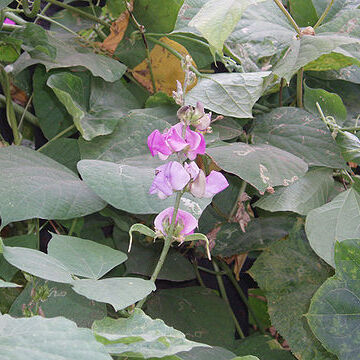Herbs or shrubs, erect, climbing or prostrate, sometimes with carrotlike woody rhizomes. Leaves pinnately 3-foliolate, subdigitate, or 1-foliolate; stipules basifixed; stipels present. Racemes axillary or terminal, sometimes subumbellate, or flowers solitary, axillary. Calyx 5-toothed, 2-lipped, upper lip entire or bifid, lower lip 3-toothed. Corolla white or purple; petals clawed; standard suborbicular, often with inflexed auricles and appendages at base; wings obovate or oblong, ± adherent to keel; keel incurved, often beaked but not twisted. Vexillary stamen free, remainder connate into an open sheath; anthers uniform. Ovary 3-12-ovuled; disk present; style swollen and ± twisted toward base or narrowed from base to tip, glabrous or shortly pubescent all over, or with a ring of hairs around terminal capitate stigma. Legumes straight or arcuate, flattened, not septate. Seeds ± flattened, arillate or strophiolate; hilum short, usually central.
Cal-tube hemispheric, slightly oblique, 4-lobed by fusion of the 2 uppermost; upper lobe broadly triangular, barely emarginate; lower 3 lobes lance-triangular; standard oblate, broader than long, with 2 prominent keel-like appendages at the base within; wings long-clawed, the obovate blade upcurved; keel-pet narrowly oblong, bent upward at the middle at about a right angle; stamens 10, diadelphous; style bearded along the upper side; fr oblong, flat, few-seeded; herbs with large, 3-foliolate lvs and axillary racemes of medium sized, anthocyanic (white) fls. 60, Old World.
Corolla small to medium-sized, pale to bright yellow or more commonly pale to deep purple, glabrous; standard roundish, often auriculate with small, oblong, cone-shaped appendages c. 2 mm long; wings obovate or oblong; keel not twisted (as in some species of Vigna) but often beaked.
Herbs or shrubs, often suffrutescent with annual stems from a perennial rootstock, prostrate, climbing or erect; rootstock often large and woody or fibrous, containing a reddish resin which occurs as reddish dots in other tissues of some species.
Ovary 3–12-ovuled; style swollen, thickened, often twisted towards the base, usually glabrous (pubescent in some South African species) and usually with a ring of hairs (penicillate) around the terminal capitate stigma.
Inflorescences axillary, sometimes appearing falsely terminal; flowers solitary or arranged in fascicles (clusters), in pseudoracemes or occasionally subcapitate.
Leaves 3-foliolate, pinnate or rarely digitate, or l-foliolate, often developing after the flowers; stipules and stipels present.
Calyx 5-lobed, the upper pair of lobes almost or completely fused to form an entire or bifid tip.
Vexillary stamen free, rarely with a tooth at the filament base; anthers uniform.
Seeds compressed; hilum short and usually central; aril only slightly developed.
Pods straight or curved, laterally compressed, not septate.

